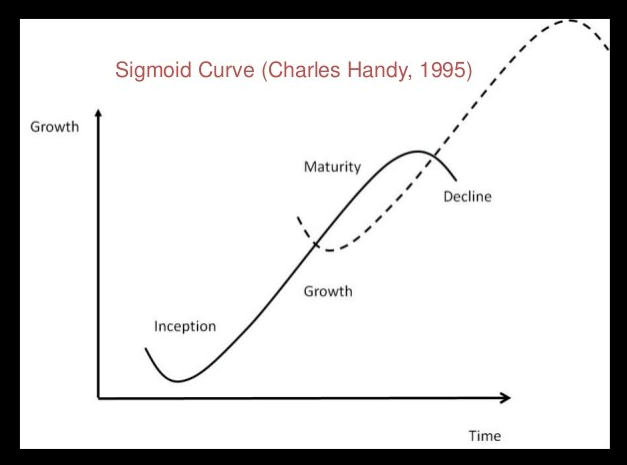Most organizations are “allergic” to change. It is time-consuming, challenging and provokes stress among staff, Board, volunteers, and clients. Yet change is a way of life in today’s contemporary organizational life. The question is not “Whether to change?” but rather “When to change?”
Charles Handy, Britain’s leading thinker on management and organizational change discusses change in a number of his books. In his latest book, The Second Curve; Thoughts on Reinventing Society, he uses the Second Curve concept to talk about reinventing society. The Second Curve highlights how all organizations change over time, whether they are countries, businesses or non-profits.
The Second Curve is based on the sigmoid curve which is an S-shaped curve on its side.
As organizations grow they rise up the curve. Eventually, all organizations peak and begin to decline. Research has shown that businesses used to have a lifespan of about 40 years before they went into decline or were taken over. In today’s world of rapid change, this span has decreased to about 14 years. But Handy states that this decline does not have to occur. Renewal can be planned if an organization is willing to “jump” onto a Second Curve.
The best time to jump onto a Second Curve is when an organization is at the “top” of its game or high on the first curve. It can then use its positive momentum and strengths to make the jump to a “Second Curve”. All change takes energy and there is often a slowdown in productivity when a change occurs, but the growth upward can be quick if an organization makes the change when it is strong. Unfortunately, organizations often wait until there is a crisis and they are on the downward side of the growth curve before changing. At that point, the initial part of the change process takes the organization even farther down the curve before it begins to move upward again.
In this case, an organization often not only loses productivity during the change process but when it waits until it is already in a downward slide it often goes backward for awhile before it begins to move forward and upward again.
Handy’s primary premise is that it takes much less energy to change when an organization is in a position of strength and is successful than when it is in a position of weakness and in decline. Unfortunately, there is less drive to change when an organization is in a position of strength. Hence, it is very important to be aware of trends impacting your organization or sector and identifying when to move forward with change, even if things are going extremely well…
Visit Osborne-group.com for other Principals’ ideas and opinions on a range of topics. The Osborne Group provides interim executive management, consulting and project support across all sectors and over a broad scope of service areas.






